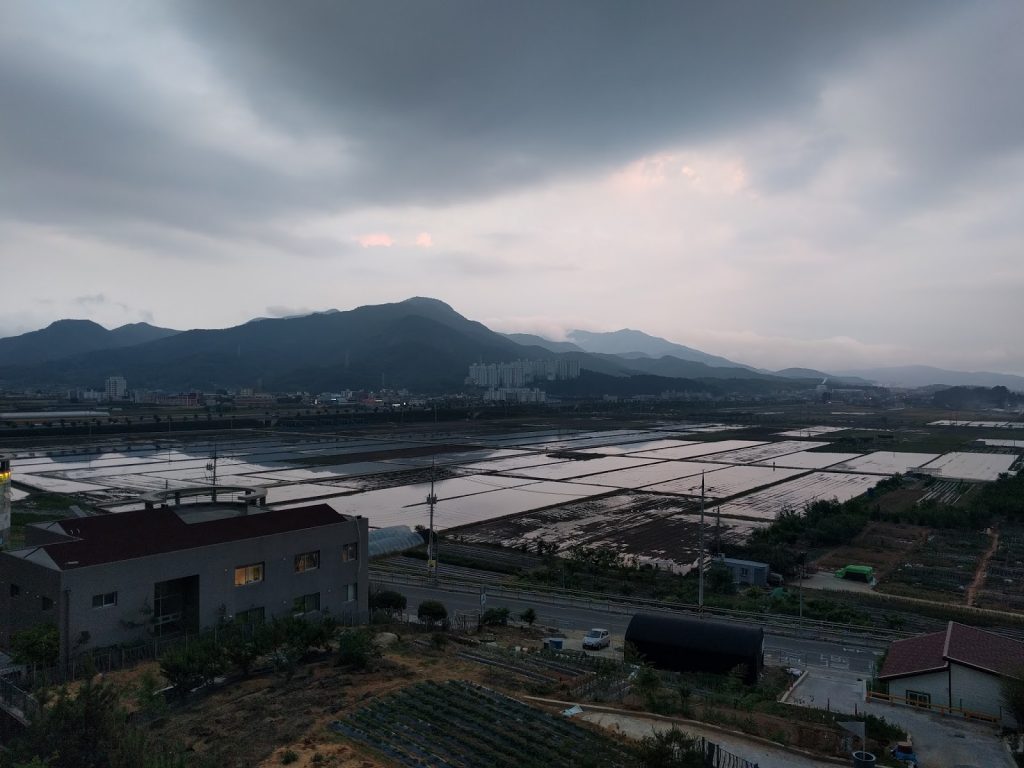The rice fields outside our window are slowly coming to life. Over the past month, farmers prepared and planted the fields. It’s been an interesting process to watch, because I know next to nothing about rice farming.

First, they flooded the fields, then tilled them. This seemed like an interesting order of events to me, but they obviously know what they’re doing. I also saw a guy walking through the sodden fields throwing around what had to be fertilizer.

It’s hard to see from our apartment, but a walk through the paddy fields revealed that they are, in fact, terraced. Each paddy is about 1-2 feet lower than the one east of it. Directly to the east of us in the mountains is an earthen dam blocking up a small river, and I presume the water is flowing from there, as there is a canal system all throughout the fields around us from the highway to beyond the lotus pond. There are very many earthen dams all over the mountains in this district, due to all the agriculture.

The rice plants were brought in on trucks and dropped along the edge of the fields until the field was ready to be planted. Apparently, rice seeds are planted in March or April in very wet seedbeds. They germinate and grow up thickly, like the grass of a lawn. However, they need more space to mature, so in May and June they are transported to the paddy fields and planted a foot apart in rows.

Historically, planting was done by hand, but today they have a special tractor that plants the rice. It’s called a Rice Transplanter. Unfortunately, I was never in a position to run down and take a closer photo when they were using it, but I wanted to because it is a fabulous little thing. The flats of rice plants are loaded onto an angled platform and gravity feeds them towards a row of spinning forks that grab each little plant and poke it down into the mud. It can plant about six rows at a time. Rice Transplanters were developed by the Japanese in the 60’s and are now fairly common in east Asia, where labor rates are high. This has to be better for the farmers, though, because so many of the old Korean ladies around here are very, very hunched over from years of working in the fields.

Agriculture in South Korea has long been dominated by rice. Koreans have been growing rice for thousands of years, and it even has helped shape Korean culture. Planting and harvesting rice requires the cooperation of an entire community, and some scholars argue that this is one reason why Confucianism, with its emphasis on social harmony, has been so prevalent in Korea.
Today, rice remains one of Korea’s biggest (and most government protected) crops. However, rice consumption is the lowest it’s ever been here, as industrialization and the need for convenience has increased demand for wheat (for bread, noodles, and pastries) and prepackaged foods. And even though there are tons of rice paddies around, I would not describe it as monoculture. Right in the middle of the rice paddies we can see are a couple of wheat fields. There is also barley, many fields of cabbage and onions and soybeans, some pepper and tomato fields, and some kind of fruiting trees I don’t recognize. Kiwis are also pretty common down near Samcheonpo.

The whole planting process definitely seems to be a community or family experience, because we have noticed tractors (and the rice transplanters) being used at multiple (disconnected) fields. I’ve heard that extended families and neighbors will share machines, and also that farmers often have multiple small fields in many locations, so it is not uncommon to see an old farmer driving his tractor down the road (or sidewalk!) from one field to the next. Unlike most developed nations, Korea still has a large number of small owner-operated farms. The average farm size in Korea is 1.2 acres, compared to 71 acres in the U.S. But the country is extremely mountainous, and only 15-20% of its land is arable.

And with increasing urbanization and foreign trade, the number of Korean farmers has shrunk dramatically in the past few decades. Agriculture’s contribution to GDP dropped from 40% in the 1960’s to 2% today. And agricultural labor dropped from 50% to 6%, while the average age of farmers has increased from 45 to over 60. All around the country, you can see farm land being converted into high-rise apartment complexes or industrial buildings.

For the next couple months, the rice paddies around us will remain flooded. Korea’s climate is actually ideal for rice: the rainy season begins soon after transplanting, keeping the land wet. By the time the monsoon ends in late summer, the plants are big enough to switch to dry land growth and the fields are drained. By October, the rice is fully grown and ready for harvest. Chuseok, or Korean Thanksgiving, takes place in October and celebrates the bounty of the harvest. It is one of Korea’s most important holidays.
…Or so I hear. I suppose I’ll find out for certain soon enough.


